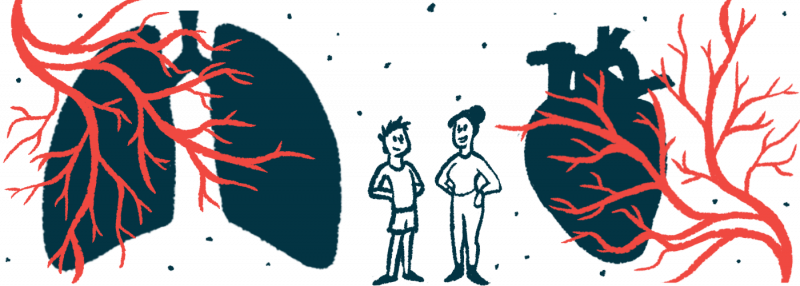|
Pulmonary hypertension (PH) is a rare but life-threatening disease that affects the blood pressure in the lungs. In PH, the heart needs to work harder to properly pump blood to the lungs, causing symptoms such as shortness of breath, fatigue, dizziness or fainting spells, chest pressure or pain, irregular heartbeat, bluish color to the lips and skin, and swelling in the ankles, legs, and abdomen. There is no cure for PH yet, but there are therapies that can help manage the disease. Living with a chronic disease like PH can be challenging. It can affect a person’s ability to accomplish daily tasks, as well as their quality of life. In addition to taking prescribed medications, patients can also make changes to their lifestyle and adopt different strategies that may help them cope with the disease on a day-to-day basis and lead as fulfilling a life as possible. |
|---|
 Did You Know? Caregivers of patients with PH are responsible for many aspects of care such as administering medications, synchronizing medical visits and treatments, organizing routine activities of daily living, and providing emotional support. The burden of caregiving can cause caregivers to be isolated from active daily and professional activities, which can affect their own health. A small 2020 study conducted in Turkey found that the higher the caregiver burden, the lower the quality of life of patients. This research highlights the importance of caregivers prioritizing their own health as well as that of their patients. |
|---|
“This past year, giving myself permission to ‘be’ helped me accept my bad days as they happened. I had to learn how to rest, listen to my body, pay attention to my body’s needs, and acknowledge when I was doing too much. … Instead of living with the fear of what my body cannot do, I am learning to trust in what it can do. Trusting myself has allowed me to let go of many fears I have been holding inside. After my surgery, fear stopped me from pushing my body past its comfort zone and making strides toward healing. Before surgery, I learned to doubt my body and what it was able to do. I was fearful of the times that my body had failed me and anticipated failure instead of accomplishments. Letting go of my fear and letting my body ‘be’ was one of the best things I did for myself.”— Brittany Foster, columnist, “Recharged and Rewired” |
|---|


Factors That Affect Overall Wellness in PH Patients
Exercise
When medically supervised, exercise can help patients alleviate the symptoms of PH. However, the paradox of PH remains that exercise is made more difficult by these very symptoms. Currently approved therapies for PH are mostly designed to make exercise more tolerable for patients.
There is not substantial information regarding the impact of exercise on patients with PH, but researchers generally believe that people with the disease can benefit from regular, moderate exercise.
Even patients with severe PH can see improvement from exercise because toned muscles use oxygen more efficiently than flaccid muscles. Regular exercise increases cardiovascular and muscular fitness, controls weight, and decreases the risk of systemic hypertension and heart disease. Additionally, while alleviating PH symptoms, exercise reduces the risk of other chronic disorders such as diabetes, improves mood, and combats depression.
No standard exercise program or plan exists that every PH patient can follow — the proper fitness plan depends on a patient’s disease severity. Before beginning exercise of any kind, patients with PH need to be extremely careful and consult with their physician for a safe and sensible regimen.

 Did You Know? The 2015 ESC/ERS Joint Task Force for the Diagnosis and Treatment of PH suggested supervised exercise training as a therapeutic strategy for PH patients. While effects of long-term exercise training in this patient population have not been thoroughly evaluated, current research shows promising indicators. In 2021, results from a small clinical trial showed that a six-month exercise training program led to long-lasting and significant improvements in the physical and psychological well-being of patients with PH. |
|---|
“Earlier this year, I was exercising daily and felt great. But in the last few months, I fell out of the habit and found myself nervous about diving back in. … So I told myself it was OK to start small.Rather than taking out my gym clothes and launching straight into the things I was doing earlier this year, I took some time at the beginning and end of each day to dance around my kitchen to my favorite upbeat tunes. It felt great to get my body moving, even if I wasn’t doing traditional exercises.By making this small change, I felt my breathlessness on the stairs decrease, and I’ve had more energy lately. I now feel comfortable incorporating elements of my previous workouts into my new routine, such as using resistance bands and ankle weights.”— Eleanor Bird, columnist, “Chronically Uncool” |
|---|
 Did You Know? Metabolic syndrome is highly prevalent among people with PH who have heart failure with preserved ejection fraction, meaning that the heart pumps normally but is too stiff to fill properly. In these cases, the ketogenic diet, which is low in carbs and higher in fat, appears to be safe and effective in treating PH associated with metabolic syndrome, according to a case report published in 2021. |
|---|
“For my son, Cullen, gaining weight was a huge and frustrating challenge, especially when decline led to right heart failure. His dietitian frequently lectured him about consuming enough calories, vitamins, and nutrients and making sure he was drinking enough water — but not too much.As he got sicker, food made him feel nauseous, and he often lacked the energy to try to eat. To make matters worse, he quickly burned off calories because his sick heart and lungs were constantly pumping hard to keep him alive.Through trial and error and with approval from his doctor and dietitian, we found ways to help him gain a few pounds, or at least maintain his weight. Encouraging him to snack throughout the day instead of forcing him to eat three big meals turned out to be a better plan. Our focus was on increasing calories and calcium while maintaining a low-sodium diet.”— Colleen Steele, columnist, “Life as a Caregiver” |
|---|


Smoking
Smoking leads to an estimated two to four times higher risk for coronary heart disease and stroke and 25 times higher risk of lung cancer. Numerous other conditions are related to smoking, including PH. For a person with PH who smokes, one of the most valuable lifestyle changes they can make for their overall wellness is giving up the habit. When patients are not able to give up smoking, the progression of the disease tends to be faster while the quality of life is decreased.
Those patients who continue to smoke are more likely to have exacerbated symptoms, including shortness of breath, fatigue, dizziness or fainting spells, pain or pressure in the chest, irregular heartbeat, difficulties exercising or even performing daily activities, and swelling in the ankles, legs, and abdomen. Quitting smoking, however, can be difficult, and patients should consult their physicians to design a smoking cessation plan or to get medication prescribed for this purpose.

 Did You Know? Cigarette smoking is known to be associated with PH in human and animal models, but the role of nicotine in this disease is less well understood. In the era of electronic cigarettes (e-cigs), which allow nicotine to be inhaled as a vapor and which are rising in use as cigarette smoking declines, determining if a link exists between this compound and disease is important. A recent study in mice found that chronic nicotine inhalation is enough to trigger changes in pulmonary arteries and in the heart’s right chamber, which can cause PH. |
|---|
 Sleep Sleep is one of our body’s most vital functions. Living with PH makes sleep that much more important — but also sometimes more difficult. Creating a bedtime routine is highly recommended, which includes setting up a time to go to bed and preparing for sleep by engaging in relaxing activities. The more consistent this routine is, the better the results will be. Sleep Apnea Sleep apnea is a potentially severe sleep disease that causes people to stop breathing repeatedly for short periods of time while they are sleeping. It is among the most common diseases that cause PH and cardiovascular disease. Patients may need a continuous positive airway pressure machine, or CPAP, to improve cardiac function and quality of life. These machines may contribute to poor sleep because of their sound or the fit of the mask. Patients should work with their healthcare team to get a quiet device and comfortable-fitting mask that are conducive to their needs. One tip is to move the concentrator into another room so that the bedroom is quieter. Here are six steps to add to your nightly sleep routine that should help you let go of the day’s worries and sink into a better night’s sleep: |
|---|
Unplug Before Bed
Avoid checking email or browsing social media on your phone right before bed; the blue light from electronics interferes with the sleep cycle because it suppresses the production levels of melatonin, the hormone needed to help induce sleep.
Sleep With an Eye Mask
Sleep masks can help promote better rest by blocking out light and sending signals to your body that it is time for bed. They can also help to bring a sense of calm by reducing racing thoughts and anxiety.
Get Comfortable Sleepwear
Wearing something that is comfortable can boost your confidence and also make you more inclined to take care of yourself. A good pair of pajamas can help you get a good night’s rest, and changing into them each night during your nightly routine can help signal to your body that it is time to prepare for sleep.
Use Soothing Scents
Calming scents can help us feel relaxed enough to get a good night’s sleep. Lavender has a variety of therapeutic benefits and is most commonly associated with relaxation and sleep. Be sure to ask your doctor before using essential oils to ensure there are no interactions.
Read Before Bed
Having a reading ritual before bed can help prepare your body for sleep and release the stresses of the day. Reading a few pages before bed can help you fall asleep faster and enjoy better-quality sleep.
Meditate Before Sleep
Studies have shown that practicing meditation and other mindfulness exercises can help us improve our sleep. Meditation often helps us sleep better by triggering the relaxation response.
 Did You Know? Studies have linked sleep apnea to various forms of PH, but research exploring sleep apnea in people with chronic thromboembolic pulmonary hypertension (CTEPH) is lacking. Further, sleep apnea also is associated with proteins that cause inflammation in people with systemic heart failure, but little is known about the levels in CTEPH patients. In a recent sleep study, researchers found that people with CTEPH experience more breathing stoppages during sleep, lower blood oxygen, and higher levels of pro-inflammatory proteins in the blood than people with idiopathic pulmonary arterial hypertension (PAH) who have similar pulmonary artery pressure. |
|---|
“Everyone feels the effects of a bad night’s sleep. But for those with chronic illness, sleepless nights can be debilitating.Since being diagnosed with PH, I have found that if I sleep poorly, I struggle to function, which can make surviving a day at work nearly impossible.The irony is that while those with chronic illness often need more sleep, chronic conditions can make sleeping more difficult.”— Eleanor Bird |
|---|
 Did You Know? Results from a 2018 review of studies showed that the prevalence of depression in patients with PAH ranged between 7.5% and 53% — significantly higher than in the general population (6.7%). Anxiety and panic disorders also occurred in 19% to 51% of PAH patients. Researchers have found that non-pharmacological approaches such as relaxation training, slow breathing, and cognitive behavioral therapy can help lessen anxiety and depression in these patients. |
|---|
“If you have found yourself standing in a warm shower as tears stream down your face, you are not alone. It is no secret that living with a rare disease like pulmonary hypertension affects one’s mental health. . . Because I have had PH for 15 years, I have many PHriends who have multiple mental illnesses related to PH and coexisting conditions. I am grateful, or so I thought, that I mostly struggle only with anxiety. It’s not that having anxiety is fun, but when compared with what others go through, it could be worse.”— Jen Cueva, columnist, “Worth the PHight” |
|---|

 Living Well With PH
Living Well With PH

